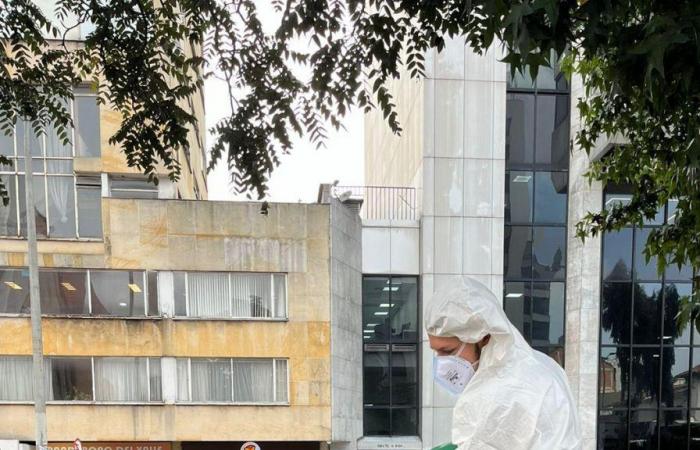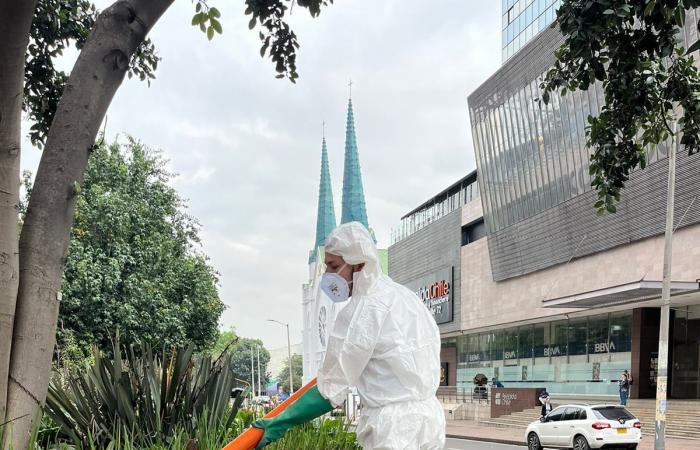The proliferation of rodents in various sectors of Bogotá has never been felt more than today. This Monday it was evident through A video that went viral showed that the area surrounding the financial center on 72nd Street is invaded by rats, exactly between Carreras Novena and Carrera Eleven.
According to the criteria of
Not only is this place one of the most visited points by international business tourists, but there is an abundant floating population that works or visits the restaurants and shops in the sector. “This city is ashamed. The filth of the people and the lack of presence of pest control organizations is unacceptable,” says one of the citizens in response to the complaint.
This city is ashamed. The filth of people and the lack of presence of pest control organizations is unacceptable
Councilor Diana Diago has also denounced several critical points. He shared the complaint from neighbors of the El Rincón Charaleño restaurant who said that, in front of the restaurant, located on Carrera 122 C No. 128 A, there are accumulations of garbage, which has caused rats to be seen in the area. “Citizens have at least the right to enjoy a clean and healthy space. The inhabitants of the area have been complaining for a long time about the garbage and the presence of rats. Clean City, garbage collection operator in the town, needs to be present in different parts of the town. The residents of the sector are desperate, they have even turned to the mayor of the town of Suba and the institutions do not respond,” said the lobbyist.
Another critical point is the vicinity of the Ciudad de Cali avenue with 66th street in the town of Engativá, in the Los Angeles stormwater channel. “The homeless have filled this place with garbage, they defecate, they have sexual relations and the rats circulate everywhere,” said an affected citizen.
Rats in Bogotá
Photo:Nicole Romero.
There are several aspects that concern health professionals in these scenarios, the first and most serious is the bite, since there is a risk that these rodents are carriers of rabies.
In it Cedritos sector There are also complaints. A citizen reported that between streets 147 and 152, there have been infestations. “This is very dangerous for all residents.”
And so there are cases reported in practically all localities, but the responsibility for the situation is attributed first to the poor disposal of garbage by citizens and second to insufficient management of the Ministry of Health of Bogotá and the Administrative Unit of Public Services (Uaesp), each with different responsibilities.
According to Elkin Alexander Sánchez, epidemiologist and dean of the Faculty of Health Sciences at the University of La Salle, referenced on the institution’s page “there are four elements that concern health professionals in these scenarios, the first and most serious is the bite, since there is a risk that these rodents are carriers of rabies, a virus with 100% lethality, the second element is that, passively, rats and mice transmit diseases such as leptospirosis and salmonellosis, through their excrement.”
The other two factors that, for the Lasallian teacher can cause serious public health problemsare related to the allergies that can be caused in both children and older adults by the antigens contained in the urine and fecal matter of these rodents, in addition to the damage to infrastructure that they can cause, such as the rupture of tubes and wiring in different sectors of the city.
Leptospirosis is a disease caused by bacteria in the urine of rats.
Photo:iStock
Disease risk
According to the same Ministry of Health, this year there have already been seven cases and 88 reported as suspected leptospirosis. This is a disease of bacterial origin, transmitted mainly by rodents and other domestic and wild animals that, when urinating, contaminate water, soil and food. And although there is an 11 percent reduction compared to the same date last year, the situation is still worrying.
“Previously this disease was associated with rural areas, but in recent years it has moved to urban settings. The bacteria survives for a long time in water or in humid environments, so it is important to be vigilant and avoid sources of infection,” he explained. Julián Fernández Niño, the Undersecretary of Public Health.
What does the District do?
Since March, the North ESE Integrated Health Services Subnetwork has been meeting the requirements of the residents of 72nd Street and 11th Street. There were three interventions with chemical control carried out. However, in the last visit to the sector, the presence of factors that encourage the proliferation of rodents was evident, such as: garbage and debris in the separator, lack of maintenance in green areas and settlement of homeless people.
Currently, the Subred team works hand in hand with the Local Mayor’s Office of Chapinero, the UAESP and the Metro company on sanitation, social and environmental management plans. Fernández Niño pointed out: “With these actions we want to take care of the people of Bogotá and prevent them from this and other diseases, to this end we invite them to maintain a good diet, constantly wash their hands and maintain good hygiene at home and clear any debris from the areas. adjacent to the living spaces.
Intervention with chemicals on 72nd Street.
Photo:Health Secretary.
From March to June 18, 2024, the entity, through the North ESE Integrated Health Services Subnetwork, has intervened 23,424 m2 in this sector of 72nd Street, using special chemical baits to exterminate rodents.
Although they have been advancing activities and citizen awareness operations have been carried out in coordination with the Local Mayor’s Office of Chapinero, the Special Administrative Unit of Public Services (UAESP), the Government Secretariat and the José Celestino Mutis Botanical Garden of Bogotá; It is necessary that the control of these animals in urban areas be comprehensive. “It is imperative to intervene in the factors that promote their presence, reproduction and proliferation; and propose and generate healthy environments that mitigate the risk to the health and quality of life of the inhabitants of the District,” said Niño.
The towns that have had the greatest intervention between January and April 2024 are: Ciudad Bolívar with 12% (231,000 m²), Kennedy 11% (202,000 m²), Usme and Bosa 10% (196,848 and 188,690 m² respectively) and Santa Fe with 8% (149700 m²).
The entity highlights these localities that, in addition to being densely populated and housing a third of the total population of the city, that is, 37%, they also concentrate different economic activities, these being factors that, if not managed properly, will constitute facilitators of conditions for the proliferation of synanthopic rodents.
The latter is a name used for any wild or domestic species that uses resources from anthropic areas, that is, inhabited by man, either permanently, using them as a living area, or temporarily, as a place of passage or rest.
Containers will continue to operate until 2026
According to the Uaesp, the surface containers installed in the city to handle usable and unusable waste, which generate so much love and hate and which are also blamed for the proliferation of pests, are a contractual aspect of the current concession.
This means that its operation must be guaranteed until the end of this scheme in February 2026. “As part of the structuring process of the new process, the conditions to incorporate mechanized collection systems through containers in the new service provision scheme are being evaluated.”
Citizens must avoid sanctions for their own health
- Take out the garbage at times not authorized by the company providing the service or in a place other than your place of residence or domicile.
- Do not use the containers or other elements provided to deposit garbage.
- Throwing solid waste and debris in places of public use, not agreed upon or authorized by the competent authority.
- Spread, partially or completely, the contents of garbage bags and containers in public spaces or common areas, once placed for collection.
- Leave garbage scattered outside its bags or containers once recycling has been carried out.
- Improperly disposing of inedible dead animals or parts of these in domestic waste.
- Make difficult, in some way, the activity of sweeping and collecting garbage and debris, without prejudice to the activity carried out by people who are dedicated to recycling.
- Throwing garbage, tires, waste or debris in public spaces or on public or private property.
- Promote or contract the transportation of debris in unsuitable or inadequate means.
- Improvise and install, without legal authorization, containers or other types of containers, intended for the disposal of garbage.
- Transporting debris in unsuitable or unsuitable means.
- Do not collect solid waste at the times established by the collection company itself, unless prior information is duly publicized, informed and justified.
- Throw any object, substance, waste, debris, sludge, fuel and lubricants into the sewage, aqueduct and rainwater networks that alter or obstruct normal operation.
- Allowing the presence of vectors and/or not carrying out appropriate practices to prevent their proliferation in urban properties.
- Do not allow public health campaigns for vector-borne diseases to be carried out within the properties mentioned in the previous section.
CAROL MALAVER
DEPUTY EDITOR BOGOTÁ
Write to us at [email protected] If there is also a rat proliferation crisis in your area







